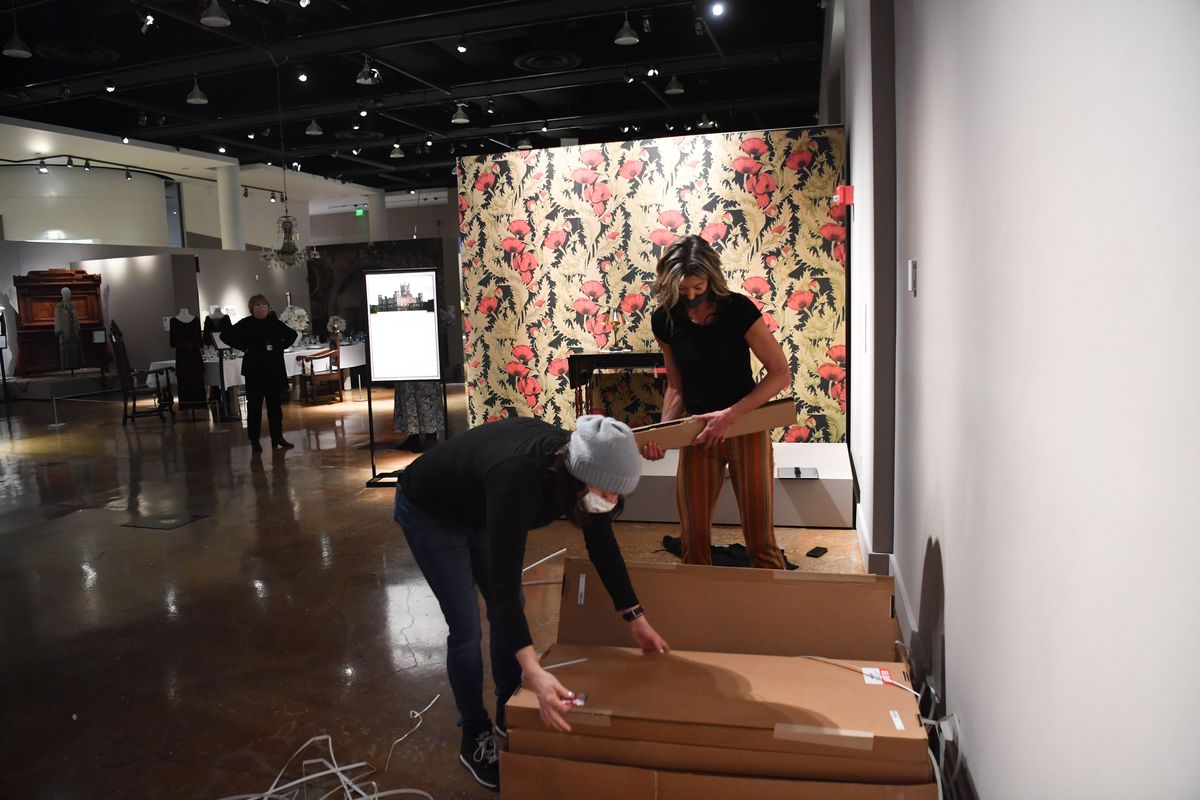Along with ‘Downton’ costumes, you can see artifacts from Spokane’s real-life power families at the MAC

Intricate beaded and lace costumes worn by the cast of “Downton Abbey” don’t stand on their own at the Northwest Museum of Arts and Culture.
They’re staged among antiques from Spokane’s rich and powerful families on minisets put together by the Spokane Civic Theatre, said Freya Liggett, curator of history at the MAC.
“We’ve been living primarily digitally for a year now. Here you can be grounded with real objects,” Liggett said. “Whether they represent fictional or real people, there’s a lot of truth to these sets.”
The PBS series followed the lives of servants and aristocrats at a Yorkshire country estate from 1912 – the sinking of the Titanic, to be exact – to 1927. At the MAC, curators have tied in costumes from the show with local history from the same time.
Next to two ornate costumes sits a massive globe owned by Louis Davenport, who established the Davenport Hotel in downtown Spokane.
“I love that you can tell someone must have pointed at Spokane a lot,” said Brooke Wagner, exhibits manager.
Wear on the otherwise colorful globe would make Eastern Washington appear to be a single, giant white crater.
In another area, there’s an early 20th century Tiffany lamp from a collection donated by the Cowles family, who founded and still owns The Spokesman-Review. In the kitchen set, an intricate cast iron stove once belonged to Spokane’s historic Fort Wright museum before it was shut in the 1980s, Liggett said.
“When we get a traveler, it’s not just opening a box and putting it up,” Wagner said.
The clothes, jewelry and hats worn on the show make up the traveling exhibit “Dressing the Abbey” that some museums might have propped up on its own.
Wagner said despite having only four months to design the exhibit – they usually like to have one to two years – staff at the MAC have taken advantage of downtime during COVID-19 closures to carefully plan each exhibit. They’re already planning for 2025.
This time around, they’ve scrutinized each detail – every prop and antique, the system of stage lights carefully illuminating each set and projections on two walls.
The whole exhibit ties in with another showcase called “Spinning a Yarn” at the Campbell House built in 1898 by the exorbitantly wealthy Spokane Campbells, who made their riches in the mining industry.
“It really catapulted them into a wealth stratosphere that was almost unmatched around the country,” Liggett said.
Normally open year-round with new exhibits, the Campbell house hasn’t seen a visitor since the pandemic started. This weekend, the exhibit preview for museum members will bring the first guests in nine months.
The mid-COVID museum experience brings some benefits, too, Liggett said. Guests – up to six people from a single household – schedule their visits online and get the exhibits to themselves.
Carol Summers, director of marketing at the MAC, said people have been “very generous,” and they were able to shift right away to creating online resources.
At the Campbell house, rooms on the first floor seem to have been originally designed with a theme country in mind. Now, each room also displays stories and outfits belonging to an important Spokane figure who lived during the “Downton Abbey” 1912-27 period.
The baroque-esque bright pink “French” room shines a light on Mabel Williamson, a pretty aristocrat whose 1914 divorce was splashed across The Spokesman-Review and Spokane Chronicle, Liggett said. Williamson also lived in the Campbell house for two months as the Campbells toured Europe, bringing back heirlooms that fill the house today.
Like the estate in “Downton Abbey,” the Campbell house had a section for servants, the size of a large home itself. There were usually about seven staff living on the property at all times – a cook, maids and men who drove the family’s coaches.
Also like in “Downton Abbey,” the house was equipped with a system to alert servants of assistance needed in any given room. In the fictional Yorkshire estate, there are large bells – a replica from the show is set up in the exhibit. At the Campbell house, a smaller box of mechanical arrows buzzed and turned to point at whichever room needed tending.
Although it’s been a tough year for the museum, with its major fundraising events canceled, it’s also made visitors more aware of how valuable an in-person museum experience is, Liggett said.
“I think that’s one thing we’ll come out of the pandemic with. This is not just staring at objects,” Liggett said. “I think objects hold memory. You have to be able to access it, but even if you think of heirlooms or toys of your own, you can hold that and capture that feeling again. This might not be as personal, but it’s meaningful.”
Editor’s note: This story has been updated to include the correct spelling of Freya Liggett’s name.